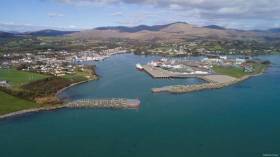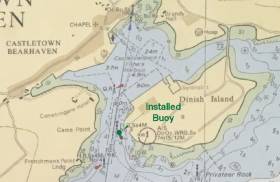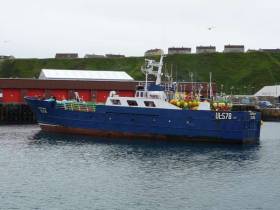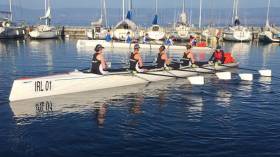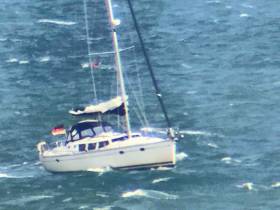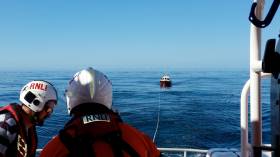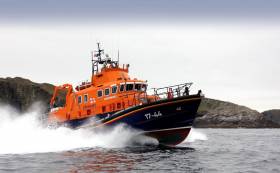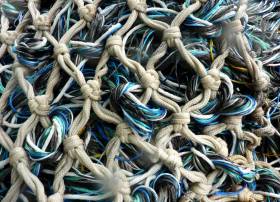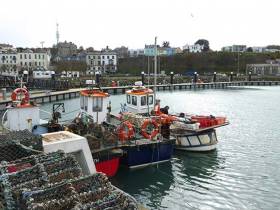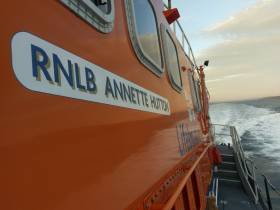Displaying items by tag: castletownbere
Green Light for Major Castletownbere Quay Extension
The Minister for Agriculture, Food and the Marine, Michael Creed TD, today welcomed the formal granting of planning permission for a 216 metre quay extension project on Dinish Island, Castletown Bere.
Welcoming the decision by Cork County Council the Minister said ”The granting of planning permission on May 1st paves the way for works to start on this project, which has been in gestation for some time.”
The new project is being undertaken in tandem with the development of a fit for purpose Harbour Administration Building on the mainland and will bring the facilities in Ireland’s Premier white fish port up to best International Standards.
The Minister added: “On foot of receiving Planning Permission my Department has now instigated a formal tendering process for the construction works with a closure date of June 8th. On completion of the tender process I expect to be in a position to award a contract and for works to commence by the end of October”
The major quayside extension is in direct response to the increased fishing activity in Castletown Bere since the last major development in 2010. Overall landings have increased from 19,030t in 2010 with a value of €29.9m to 30,522t and a value of €99.4m in 2017
The Minister went on to say: “Taking account of the increased level of activity in Castletown Bere and the unprecedented success in increasing landings by foreign vessels from 370 in 2010 to 1,543 in 2017, I am delighted that this major capital investment proposal has got the green light”
The Minister concluded by saying: “When completed the new facilities for the fishing industry and the wider seafood sector in Castletown Bere will be on a par with the best in Europe. This will drive forward the local economy on the Beara Peninsula and allow for a major expansion of the seafood support sector and other marine related industries in the South West. The expanded landing facilities will also provide opportunities for further economic diversification.”
Buoy Change At Castletownbere Fishery Harbour Centre
#MarineNotice - Marine Notice No 13 of 2018 advises that the No 3 Green Perch at the entrance to Castletownbere Fishery Harbour Centre in West Cork has been removed due to damage.
The No 3 Green Perch has been replaced by a 1.5m green buoy in position 51° 38’ 49.387” North, 09° 54’ 27.41” West.
The light characteristic is a green flash every five seconds. This buoy will remain in position until further notice.
For safety reasons, mariners are requested to proceed slowly and with caution when in the vicinity of the green buoy.
For further information, contact the Castletownbere Harbourmaster’s Office at +353 27 70220.
Crew Leaves Roach-Ridden Trawler Detained In West Cork
#Fishing - A UK-registered fishing boat detained in West Cork last week had to be fumigated twice to remove an infestation of cockroaches.
And according to the Irish Examiner, the Indonesian crew of the trawler Christian M have now walked off the vessel as arrangements are made for their voluntary return.
The Christian M was towed into Castletownbere on Wednesday 8 November after breaking down off the West Cork coast.
A subsequent inspection by the Marine Survey Office (MSO) led to its detention over a number of issues, including the cockroach infestation.
Ken Fleming, a co-ordinator with the International Transport Workers Federation (ITF), visited the boat yesterday (Friday 17 November) along with gardaí and an Indonesian embassy official.
“When I went onboard the vessel, I witnessed cockroaches still on surfaces,” said Fleming. “The accommodation is unfit for purpose.”
The Irish Examiner has much more on the story HERE.
Castletownbere Fly Flag for Ireland in A Final at World Coastal Rowing
#Rowing: Castletownbere, representing Ireland, finished 14th in the A Final of the women’s coxed quadruple at the World Coastal Rowing Championships in Thonon on Lake Geneva in France.
Greece won an exciting race, recovering from a mistake to take over the lead from Germany by the eighth buoy. Italy pushed into second, while Germany clung on to third. They held off Russia, who had led early in the race, by .36 of a second. Galley Flash won the B Final, and Cairndhu finished second.
Jessica Lee had finished second in the B Final of the women’s solo.
World Coastal Rowing Championships, Thonon, France, Day Two (Selected Results; Irish interest)
Women
Quadruple, Coxed – A Final: Greece (Nautical Club of Thessaloniki) 27 min 34.98, 2 Italy (CC Saturnia) 27:41.49, 3 Germany (Erster Kieler RC v 1862e V) 27:49.29; 14: Ireland (Castletownbere: E Hanley, C O’Regan, O Gilsenan, M Sheehan; cox: C Connolly) 30:42.58. B Final: 1 Ireland (Galley Flash) 20:46.06, 2 Ireland (Cairndhu) 20:56.34.
Solo – B Final: 2 Killorglin (J Lee) 23:39.30.
Coastguard Medevac Alerts In West Cork & Dublin
#Coastguard - Castletownbere’s Irish Coast Guard team was alerted on Friday night (29 September) by Valentia Coast Guard to a medevac scheduled for the early hours of Saturday.
FV Argeles, a French fishing vessel, had an injured crewman onboard and was expected in Castletownbere some hours later.
The coastguard crew and Castletownbere HSE ambulance were waiting for the trawler when it docked at 2.40am. The two crews worked together to assess and stabilise the casualty, who had sustained back injuries after a fall.
After the casualty had been transferred to the ambulance, they were taken to Cork University Hospital for further treatment. The coastguard team were stood down at 5.10am.
Elsewhere, the Marine Rescue Coordination Centre in Dublin received a request for assistance from a yacht off the coast of Malahide on Thursday afternoon (28 September).
A crew member aboard the yacht, which was en route to Dun Laoghaire Marina, was ill and required medical attention.
It was agreed that the yacht would continue to its destination. RNLI Dun Laoghaire was sent to provide an escort and also dropped crew aboard to assist.
On arrival to the marina, Dún Laoghaire Coast Guard members greeted the yacht alongside HSE paramedics and gardaí. The ill crew member was transported to hospital for further medical attention.
West Cork Lifeboats Launch To Stranded Tug & Angling Boat
#RNLI - Lifeboats from Baltimore and Castletownbere launched two separate callouts off West Cork since Friday (1 September).
Baltimore RNLI was called out yesterday morning (Saturday 2 September) to a tug with three people on board, which had broken down north of Drowlaun Point off Sherkin Island.
The volunteer crew launched their all-weather lifeboat at 9.45am after they were alerted by the skipper of the 12.5m tug. They arrived on scene seven minutes later and quickly established a tow to Baltimore Harbour within an hour.
Conditions at the time were good, with a southerly Force 4-5 wind and a calm sea ahead of the much poorer weather forecast for later in the day.
Elsewhere, Castletownbere RNLI lifeboat was launched on Friday morning to a 30ft angling boat with mechanical failure three miles south-east of Crow Head on the Beara Peninsula.
The lifeboat, under the command of Coxswain Brian O’Driscoll, was launched on service within minutes and proceeded to the casualty some nine miles southwest of Castletownbere Harbour.
The casualty was located in fine weather conditions at 11.07am. RNLI volunteers passed a towrope to the anglers’ onboard and the lifeboat took the vessel under tow to Castletownbere, where it was berthed alongside the pier 90 minutes later.
#RNLI - Lifeboat crews from Ireland will feature in a new 12-part Last year alone, RNLI lifeboats in Ireland documentary for the BBC.
Saving Lives at Sea, showcasing the lifesaving work of the RNLI, starts next Wednesday 16 August at 8pm on BBC Two.
And the first episode will include the dramatic rescue of three fishermen from a sinking trawler and the rescue of 30 people from the Astrid tall ship in Kinsale.
The 12-part series features real rescues carried out by the charity’s lifeboat crews around Ireland and the UK, and gives a unique insight into the lives of the charity’s volunteer lifeboat crew members, who rescue thousands of people and save hundreds of lives around our coastline every year.
From Ireland, the series will feature lifeboat crews from Castletownbere and Kinsale in Cork, Skerries in Dublin and Bangor on Belfast Lough.
Castletownbere will be in episode three, as the crew rescue a lone sailor in storm conditions and rescue two fishermen from a boat that sinks.
Saving Lives at Sea features real-life rescue footage accompanied by heart-warming and emotive testimonials from the crew and the people they rescue.
The series has been filmed over the past year, with lifeboat crews using RNLI and special cameras and welcoming filmmakers into their day-to-day life. Rescues from the RNLI’s archives are also revisited.
Last year alone, RNLI lifeboats in Ireland launched 1,136 times rescuing 1,649 people.
Saving Lives at Sea will be broadcast weekly from Wednesday 16 August to Wednesday 1 November on BBC Two at 8pm. The series is made for the BBC by Blast! Films.
#Fishing - The International Transport Workers Federation says it will be closely watching the Garda investigation into a Ghanaian fisherman’s claims that he was dumped at sea in a survival suit from an Irish trawler.
As the Irish Examiner reports, the crewman says he joined the fishing vessel at Castletownbere in West Cork earlier this month, and after voicing concerns about working conditions on the vessel, he sustained a back injury on deck that rendered him unable to work.
Some days later, he says a Naval Service vessel visited the boat and inquired about his condition, after which he was told his transfer back to Castletownbere was being arranged.
That arrangement, he alleges, involved him being put overboard in a survival suit and left in the water before he was picked up by another vessel. He says he then made his own way by bus to hospital in Cork for treatment.
The incident was reported on 12 May to Gardaí and the Marine Survey Office, the latter of which confirmed that both the fishing trawler and transfer vessel were inspected by its officials.
The Irish Examiner has more on the story HERE.
Ireland’s Six Fishery Harbour Centres & Small Harbours Get €28m In Funding For Capital Projects
The Minister for Agriculture, Food and the Marine, Michael Creed TD, today announced details of a €28m Capital Investment Package for the ongoing development of Ireland’s Local Authority owned small harbour network. (see Table 1 below for details)
In announcing the initiative the Minister said “The €28m I am allocating for the 2017 Fishery Harbour and Coastal Infrastructure Capital Programme represents a significantly increased capital investment in the six Fishery Harbour Centres and other fisheries related marine infrastructure. It is testament not only to this Governments ongoing commitment to the Seafood sector, but also to the success of the sector in terms of increased activity levels.”
The Annual Fishery Harbour and Coastal Infrastructure Capital Programme provides funding for development works, safety and maintenance at the six Fishery Harbour Centres at Howth, Dunmore East, Castletownbere, Dingle, Ros an Mhil and Killybegs. The primary function of the Fishery Harbour Centres is to underpin the ongoing development of the fisheries and seafood processing sectors, while also facilitating other diverse marine related activities. The annual value of all fish landings into the six Fishery Harbour Centres increased from €136.8m to €262.3m over the period from 2010 to 2015.
The Minister said “I have set aside almost €25.5m towards development works, safety and maintenance at the six Fishery Harbour Centres which account for around 85% of all fish landed into Ireland. I have also proved €2.5m for a Local Authority Harbour Development and Marine Leisure programme to assist coastal Local Authorities in the repair and development of small scale piers, harbours and slipways under their ownership.”
Flagship projects in the 2017 Capital Programme include major quay extensions at Castletownbere, Killybegs, and Howth. Also of note is the dredging of the navigation channel in Dingle, the completion of the Small Craft Harbour in Ros an Mhíl and the West Wharf upgrade in Dunmore East.
The Minister concluded by saying “This €28m investment will build on the €64m invested in the Fishery Harbour Centres since 2010 and the €23m invested in the Local Authority infrastructure over the same period. It continues to improve the facilities at our Fishery Harbour Centres and other public harbours around our coast attracting increasing and additional economic activities, benefitting a broad cohort of current and future harbour users including the fishing industry, seafood processing sector, other ancillary marine industries, and the wider rural coastal communities”.
Table 1- Fishery Harbour & Coastal Infrastructure Development Programme 2017
| Table 1. | ||||
| Location | Project Description | Cost €m | ||
|
Howth:- |
Construction of additional berthing face to middle pier and dredging along pier face. Gas Main Other Services (Sewers, ducting, watermains) Claremount Storage Units East Pier Repairs Syncrolift – Timber Deck Footpath Upgrade |
1.50 0.15 0.15 0.15 0.17 0.05 0.15 |
||
| Total | 2.32 | |||
|
Dunmore East:- |
West wharf upgrade required due to steel corrosion and spalling of concrete. Shanoon Car Park |
0.4 0.2 |
||
| Total | 0.6 | |||
|
Castletownbere:- |
Dinish island pier extension New Harbour Administration Building (shared facility) on mainland Quay. Harbour Slipway |
5.0 1.2 0.3 |
||
| Total | 6.5 | |||
|
Dingle:- |
Dredging North Channel to widen the navigation channel to the port and provide better access. Upgrade of Harbour Marine Facilities Building |
4.0 0.2 |
||
| Total | 4.2 | |||
|
Ros an Mhíl:- |
Small Craft Harbour final Phase (furniture fit out and services). |
0.8 |
||
| Total | 0.8 | |||
|
Killybegs:- |
Smooth point pier extension and permitting. Harbour Electrics Upgrade Small Craft Harbour final completion. |
5.0 0.5 0.7 |
||
| Total | 6.2 | |||
| Total Fishery Harbour Centres( new developments) | 20.62 | |||
| Cape Clear | Complete development works incl painting stoplogs, install pontoons, finish road works. | 0.1 | ||
| Safety and Maintenance and Non-Discretionary and Contractual Capital Commitments (incl Disability Access) | 4.69 | |||
| Total Local Authority Harbour Development and Marine Leisure Programme | 2.50 | |||
| Total 2017 Fishery Harbour and Coastal Infrastructure Capital Programme | 27.91 | |||
Early Hours Call For Castletownbere Lifeboat To Tow Vessel In Difficulty
#RNLI - Castletownbere RNLI was requested to go to the aid of a 36m vessel with mechanical difficulties north of the Bull Rock off the coast of West Cork on Friday evening (16 December).
The lifeboat, under the command of deputy coxswain Sean Bawn O’Sullivan, was launched within minutes and located the vessel at anchor about one hour later.
The vessel, the Ocean Guardian, was on passage from Castletownbere to Burtonport when it contacted Valentia Coast Guard.
With light winds and a 3-4m swell, RNLI volunteers passed a tow rope to the crew onboard, and the lifeboat took the vessel under tow to Castletownbere.
When off Crow Head some time later, the tow rope broke and had to be reattached. The tow was then completed without further difficulty.
The vessel was berthed alongside the pier in Castletownbere at 2.30am yesterday morning (Saturday 17 December).


























